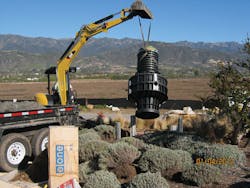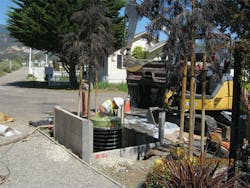Carpinteria's Septic to Sewer Conversion Project
By Joseph Harmes
Rincon Point’s powerful waves and fast breaks established it as one of Southern California’s premier surfing locations in the 1950s and helped inspire campy Annette Funicello movies, a cult of Ford Woody Wagons and the reverb-drenched guitar of the Ventures.
But 40 years after launching the careers of many of the sport’s most celebrated pioneers steering primitive 10-ft. wooden boards, the Queen of the Coast fell victim to “no swimming” signs. It spurred an expensive and often melancholic 15-year battle to remove more than 130 septic tanks contaminating the famous surfing spot before culminating in an award-winning, high-profile project of lasting guidance for other coastal communities.
The pilgrimage from pollution to the promise of a healthier ocean and better environmental quality of life for humans, seals, sea lions and the occasional gray whale appropriately began in 1998 with the surfers. Rincon “Regulars” complained the smelly water was causing rashes, and eyes, ears, nose and throat infections.
“We’re in the water, just like the animals,” said Heather Hudson, an independent film producer who created the groundbreaking documentary surf film The Women and the Waves. “We’re absorbing everything through our skin and breathing it. Swallowing it.”
The source, they insisted, was Rincon Point, a gated community of 72 homes. Thirty-nine front the ocean; while others border Rincon Creek - the boundary between Santa Barbara and Ventura counties - which flows from tributaries in the mountains of Los Padres National Forest and forms a small lagoon at its mouth on the Pacific coast.
“The problem was kind of an unknown and then we figured out it was coming from the houses,” added Hudson, who also serves on the board of directors of the non-profit citizens’ action group Heal the Ocean (HTO) and heads up its fundraising and events activities. “And then the testing was done. And it was human.”
The surfers gathered 3,500 names on a petition complaining of their ailments. HTO was founded and a meeting was organized with homeowners, officials from the small town of Carpinteria and the Carpinteria Sanitary District (CSD), although the latter lacked jurisdiction at the time.
“Ocean pollution really hadn’t been a publicized issue,” recalled Steve Halsted, the Rincon Point homeowners’ association president whose family bought their cottage in 1956 when he was 17 years old and surfing himself. “We were not aware that we were [polluting the ocean]…and if there was some data showing we were a problem, we would most certainly want to know about it!”
In late 1998, a study funded by HTO and Santa Barbara County Environmental Health Services established that septic effluent from the community was invading the beach’s leaching zone and was the main source of fecal bacteria in the ocean.
The discovery shouldn’t have come as a surprise. The first beachfront homes sprouted in the 1930s and continued until 1975; inland houses were built from 1980 onward. Most average 2,500 sq. ft. and sit on 8,000-sq.-ft. lots of porous, sandy soil. Oceanfront homes are 50 to 75 feet from the water, with the entire community perched about seven to 12 feet above mean tide level.
All utilized septic systems. A very high, tidally influenced groundwater table affected their modest leach fields; one homeowner professed he could lift his tank’s lid and watch the tide rise inside. Some systems were archaic. “Mine was one large redwood tank from 1934!” Halsted said.
Political Rip Tides
The CSD initiated The Rincon Point Septic to Sewer Conversion Project in 1999 as a long-term solution to safely convey wastewater from this environment to CSD’s treatment plant. Formed in 1928, CSD serves 4,300 accounts in Carpinteria (pop. 13,000) in southeastern Santa Barbara County. The plan unintentionally caused waves of administrative, political, legal and engineering challenges lasting a decade.
A Rincon Sewer Engineering Study funded by HTO and some homeowners originally estimated the cost of sewer hookups at $2.9 million. In 2000, 74 percent of Rincon homeowners voted to levy their homes to fund the project, which included $425,000 for an Environmental Impact Report (EIR). HTO helped secure a grant from the State Water Board in 2001 to fund the vital multi-volume EIR, which CSD approved in 2004.
The project basically languished while HTO sought funding for a supplemental report finished in 2006. In 2007, it regained traction. The Local Agency Formation Commission voted to expand the project and approved annexation of Rincon Point and the residential communities of Padaro Lane, Sandyland and Sand Point to the Carpinteria Sanitary District. HTO also worked to obtain a $2.1 million Clean Beaches Initiative Grant, which ultimately reduced homeowners’ costs by 25 percent.
Charlie Don’t Surf
Contentious opposition wracked posh Rincon Point, where homes fetch from $1 million inland to $8 million on the ocean. Legal challenges to CSD annexation compelled HTO and pro-septic-to-sewer homeowners to raise $200,000 to fight them.
“Steve Halsted worked long and hard, banging on doors and getting everyone to donate $5,000, $10,000, $20,000 - anything he could get,” said Hillary Hauser, a lifelong writer, environmental activist, photojournalist, diver, and founder of HTO.
A third of homeowners consistently voted against surrendering their septic systems. It seemed not to bother them that heavy rains saturated their marginal leach fields (with no room for expansion). Yet others “told horror stories of sewage back-ups into their houses, how their guests couldn’t take showers, they couldn’t do the dishes when it rained or flush toilets,” said Hauser.
According to Halsted, project supporters argued:
- They didn’t want to be polluters of the ocean.
- Sewer service could provide reliable waste disposal without limited household sewage use.
- With sewer service, development restrictions (room/bathroom additions) would be lifted (both Santa Barbara and Ventura counties did not allow any remodel that would add additional water fixtures).
- Upcoming state legislation would require conversion to central sewer collection.
- They did not want the community identified as a possible polluter.
- California was willing to support 25 percent of the cost with funds from a clean water bond initiative.
On the other hand, those who opposed the project - including a member of a famous Hollywood family of actors - offered myriad rebuttals, which included:
- We are not polluting the ocean so why incur the cost?
- Rincon’s annexation to CSD is too expensive.
- We are disposing of waste on our own properties. We don’t rely on government.
- Conversion will allow expansion and remodeling of existing buildings.
- Discharge from CSD will (still) pollute the ocean.
- The new system will be unreliable.
In 2008, 36 percent of homeowners voted against annexation, which then required a confirmation election in which Rincon residents voted 73-59 in favor. After a fifth lawsuit went to trial that summer, project supporters were victorious and both sides reached a settlement.
Finally, CSD annexed Rincon Point so easements could be obtained and it could legally spend money there. But it wasn’t cheap for the homeowners. In addition to legal fees, each paid for annexation.
“Seventy-two thousand dollars was the pre-paid (cash) assessment amount,” said CSD General Manager Craig Murray, a civil engineer (and surfer). “The assessment for those who took the financing was around $88,000 (currently $4,409 a year). Sand Point is $2,781 and Sandyland is $3,232. The surplus grant funds of $1.967 million were used for a bond call lowering the indebtedness.”
The Ground Game
The South Coast Beach Communities Septic to Sewer Project now encompassed seven miles of beaches including Rincon, Sandyland, Sand Point and Padaro Lane.
“(The latter) were far simpler in terms of design and constructability and far less controversial among homeowner groups,” CSD wrote.
Like earlier hurdles, the overall level of effort to finally build the project was disproportionately massive. Permits had to be obtained from numerous local, county, state and federal agencies. Engineering challenges were another issue altogether.
“When I started in 2004, the design was for a deep gravity sewer system with two separate conventional sewage pump stations, both in the floodway on the banks of Rincon Creek,” said Murray.
The gravity sewer design embodied “a number of drawbacks,” said David Rundle, the project manager and principal engineer for Penfield & Smith (today with Stantec). “First, there was high groundwater, being in a beach environment. Second, Rincon Point is the site of an ancient Chumash Village and rich in (California’s earliest) cultural resources. Permitting for excavating through the archaeological site, if allowed, was challenging and very expensive.” (Murray estimated the cost at more than $1 million.)
“The gravity system would have required multiple pump stations,” added Rundle. “Siting them within the community was challenging since real estate is at a premium and who wants a sewage lift station next to their property that requires regular inspection and maintenance?”
Every option was evaluated. “I looked at vacuum sewers and various other alignments and configurations for a conventional system,” said Murray.
A Transformational Technology
The top dog, all sides agreed, was an All-Terrain Sewer™ (ATS) manufactured by Environment One Corporation (Niskayuna, N.Y.), a company with 45 years of waterfront experience around the globe.
The ATS is a cost-effective, turn-key solution used by more than one million end users worldwide. The heart of the system is a tank about the size of a dishwasher that is buried in the ground, often within the same footprint as a decommissioned septic system. Interior components include a one-horsepower, semi-positive pump that grinds waste into a fine slurry. Its robust torque can propel the liquid through the inflow-and-infiltration-free, pressurized 2” to 4” pipe for a distance of more than two miles - even uphill - to a force main or treatment plant.
“I approached E/One after identifying the [ATS] system as a potentially viable alternative,” said Murray. “I traveled to Washington state early in the design evaluation process to look at several communities with over 1,000 E/One units in service and met with agency staff to discuss design, installation, maintenance and ownership.”
“We’d used E/One products for situations where gravity sewers were not feasible,” said Rundle. “The fact that we could install the small diameter force mains by horizontal directional drilling methods and limit the amount of open-cut excavations was important given the archaeological issue. Additionally, the pipes and other facilities could be installed at relatively shallow depths to avoid groundwater to the extent feasible,” Rundle said.
“We’ve found that E/One continually upgrades its products and its grinder pump stations are very reliable and require minimal maintenance and power,” Rundle said.
RIP Septic (1930-2014)
In 2012, workers finished converting 21 septic tanks to an ATS in Sand Point Road and another 38 in Sandyland Cove. To avoid delays, Padaro Lane residents pulled out of the project and financed their own sewer extension. “Several (from Padaro Lane) used E/One units as private pump stations because their homes were below the gravity main,” said Murray.
Rincon Point residents finally saw their boulder pushed to the top of the mountain in 2014 when 72 E/One grinder pump stations were installed.
The project’s $8,437,797 total cost is fully paid through $6,470,016 in private contributions and $1,967,781 from the grant.
“I would bet that the gravity system would have been twice the price,” said Murray. Given the ATS’s low O&M costs, CSD opted for ownership.
The project has earned the engineering firm, CSD and HTO multiple awards: Project of the Year and Public Works Project of the Year from the Central Coast Chapter of the American Public Works Association; 2014 Capital Project of the Year from the California Association of Sanitation Agencies; commendations to all involved from the California State Assembly and State Senate; and a commendation given to Heal the Ocean by the Regional Water Quality Control Board.
All-Terrain Sewers “have not been widely used in California,” said Murray. “So this project will serve as an example to other agencies pursuing septic-to-sewer conversion in constrained areas.”
Homeowners cheered their reward. “The fact that CSD structured the project so that they installed, owned and agreed to service pumps went a long way to address homeowner concerns,” said Halsted. “There haven’t been any reliability or service complaints. And, CSD completed the project under budget, so there was a rebate,” he added. “Those for the project are happy. Those against: Quiet.”
“The water doesn’t smell like sewage anymore when there’s a rain storm,” said Corey Radis, an avid surfer and Heal the Ocean’s operations coordinator. “We can go out (surfing) anytime now. We don’t worry about it.”
About the Author: Joseph Harmes is a freelance writer who has documented the evolution and acceptance curve of low-pressure sewer systems for two decades. He can be reached at [email protected] or (432) 653-0511.



